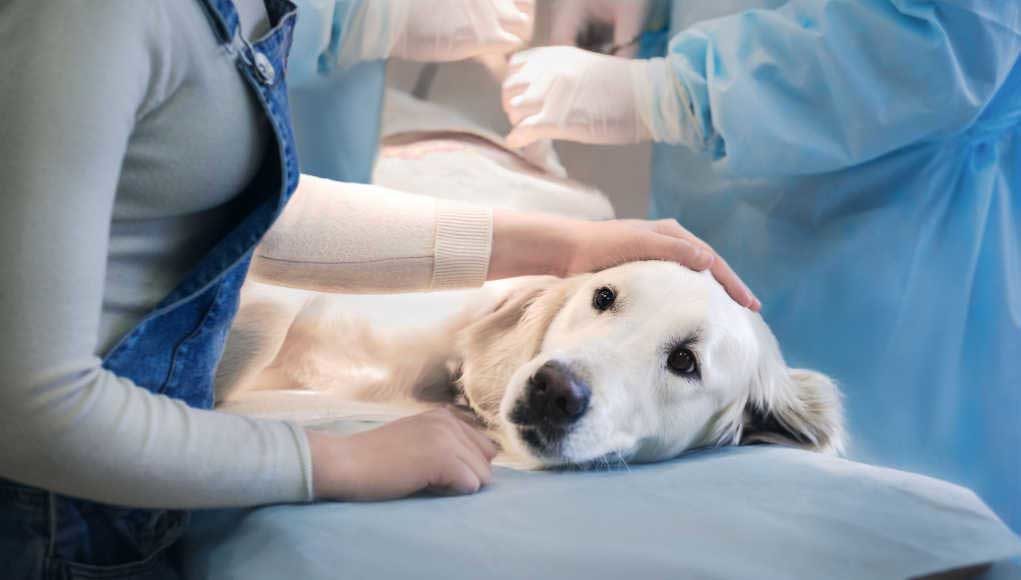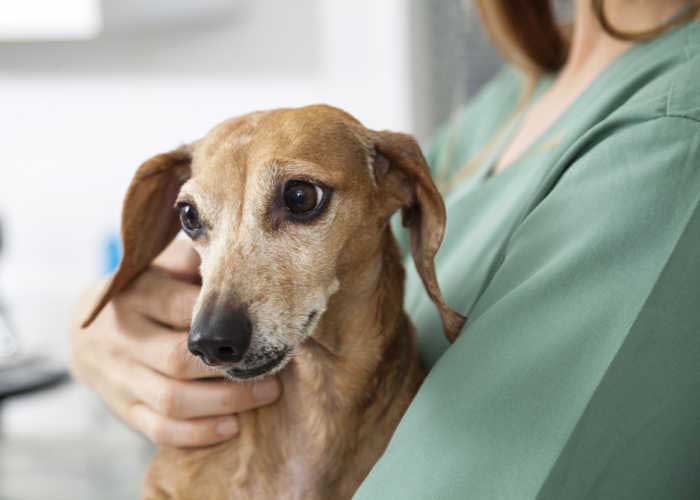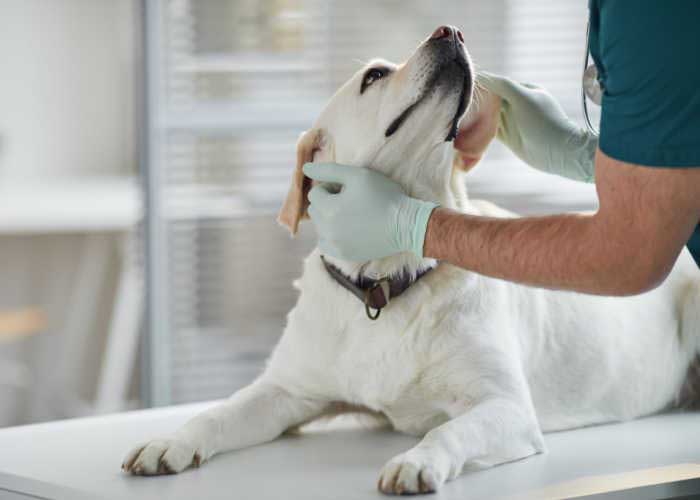Table of Contents
- How Expensive is Dog Cancer Treatment: What It's Like Nowadays
- Is there a Cure for Canine Cancer?
- Perceptions about Cancer Care
- Signs and Symptoms for Cancer in Dogs
- Diagnosis of Cancer in Dogs
- Dog Cancer Treatment Options
- How Much Does Dog Cancer Treatment Cost?
- Canine Cancer Research
- FAQs About Dog Cancer Treatment Cost
- How Expensive is Dog Cancer Treatment: Final Thoughts
If your pooch ever faces cancer, know that cancer care keeps getting better. But how costly can it be to fight cancer in dogs?
You might have not thought about it, but cancer is widespread among dogs.
Oh, you knew about it? Then, you must be one of the 90% of pet owners who are aware that dogs can develop cancer just as in humans.
But no matter how prepared you think you are, it will be one devastating day once you learn your sweet pup has it.
Whether mixed or purebred, all is at risk since canine cancer takes many forms to affect their bone, blood, and body tissues.
How Expensive is Dog Cancer Treatment: What It's Like Nowadays
You might be wondering what causes cancer in dogs. Well, you should know that its cause is largely unknown.
Although no one exactly knows why the disease develops, it may be linked to a few risk factors such as exposure to chemicals, hormonal imbalance, viral infections, or simply inherited from those developing the disease.
In the past, a cancer diagnosis left fur parents with no hope. But today, you can take comfort in knowing that pets have a fighting chance at life thanks to medical advancements.
Cancer care centers provide dog owners with clinical expertise and progressive treatment options. This means we can do so much more for our furry friends to extend their lives.
Is there a Cure for Canine Cancer?
In most cases, surgery provides a cure.
But a permanent cure is not possible for all types of cancer because the disease eventually comes back.
So, the goal is to be able to control it while providing the best quality of life for as long as possible.
The purpose of lymphoma treatment, for example, is to get the patient into remission. It is when cancerous cells are still present, but no longer impact the animal’s health.
While research is still ongoing toward finding a cure, the best thing to do is the removal or reduction of active cancer cells inside the body.
Perceptions about Cancer Care
Even though treatments are readily available to improve survival rates, many still hesitate to seek help from health professionals.
Knowing people who suffered while undergoing treatments made fur parents think their pets will go through the same pain.
But guess what?
Dogs tolerate cancer treatment well. Vets work hard to make sure they do!
Cancer care for pets is different compared to the experience for people as it was designed to make them as comfortable as possible.
To make these adorable creatures feel better is precisely what veterinary medicine is aiming for.
Another reason why some choose not to pursue cancer care is that they worry about the cost.
Veterinary oncologists have indeed undergone extensive training to offer treatments. But they will merely help us decide on what course of action to take for our dog’s quality of life.
When you decide to consult, you are not committing to a particular approach. Rather, you are opening up a conversation that will help give you more information
We know our pets more than they do. So, it will be up to us if it’s best to move forward or back off and just enjoy the time that’s left.
While treatment depends on the progression of the disease, surgery, chemotherapy, and radiation are strongly suggested to improve the chance of survival.
Signs and Symptoms for Cancer in Dogs
Canine cancer comes in all forms and locations making it difficult to detect. It even has no regard for age and breed.
Perhaps the most notable sign of dogs with cancer is the presence of tumors. It is important to note, though, that not all bumps and lumps are cancerous.
Some other symptoms associated with the disease include:
- Swollen lymph nodes
- Change in behavior and habits
- Lameness
- Pain or Discomfort
Anytime your pet is not feeling well or is showing any unusual signs or symptoms, immediately seek medical advice. See a vet for a proper diagnosis and course of treatment.
You may discuss additional testing to determine and plan the treatments that fit your pup’s needs. Talk about how large the cancer is and whether it has spread to other organs.
Regarding the treatment details, you may raise your concern about which options are recommended.
You can also ask how soon you can start the treatment and the potential side effects.
Diagnosis of Cancer in Dogs
Veterinarians have better diagnostics than ever before to identify cancer earlier and make smart decisions about what will help the patient the most.
Your vet will start with a thorough physical examination and will take into account the patient’s health history.
The diagnosis of cancer in dogs will be based upon fine needle aspiration, which uses a syringe with a thin, hollow needle to suction out a sample of cells from the tumor.
In some cases, a biopsy may be necessary wherein the doctor collects a piece of tissue from the mass to reach a definitive diagnosis.
Since most dog tumors are malignant, the doctor will have to perform advanced imaging (ultrasounds, CT scans, or MRIs) to determine the extent of the disease.
Your vet may recommend staging, which may include complete blood count, urinalysis, and chest X-rays.
Dog Cancer Treatment Options
Your veterinary or veterinarian oncologist will determine the course of your pet’s cancer treatment.
Depending on the type of cancer, the doctor may recommend chemotherapy, radiation therapy, surgery, or a combination of these dog cancer treatments.
The choice of treatment will depend on the presence of metastasis and the extent to which the disease has invaded surrounding tissues.
Surgery — $500+
As the most commonly used treatment for cancer in dogs, surgery is to physically remove as much cancer as possible.
It is best performed by surgical oncologists who have the current knowledge of tumor biology. With their advanced training, they are often board certified by the American College of Veterinary Surgeons.
The purpose of surgery for dogs is to control or eliminate local cancer (where cancer started) in hopes to improve the patient’s quality of life.
Surgical removal of localized cancer has cured more cancer patients than any other form of treatment.
But even when local control is achieved, some patients may still require other treatments to prolong survival.
Radiation Therapy — $2,000 to $6,000
It is a localized therapy, like surgery, but uses radiation to shrink or destroy cancers that cannot be entirely removed by surgery alone.
Radiation therapy for dogs is best performed by radiation oncologists.
It aims to damage the cancer cells’ DNA to interfere with their growth and replication. By killing the cancer cells, it can either shrink the tumor or completely destroy it.
This treatment modality lasts 2 to 3 weeks, although it varies.
Chemotherapy — $150 to $5,000
It is to use drugs to combat the disease – targeting and destroying cancer cells growing in the body.
Chemotherapy for dogs is best performed by medical oncologists.
The goal of chemotherapy is to prolong dogs’ survival by reducing the size of tumors in the body.
This medical protocol is often used in combination with surgery to treat various cancers in dogs.
Chemotherapy protocols range in a span from a few weeks to several months.
Visiting your vet for routine wellness exams can help spot signs while the disease is still in the early stages.
There is no known approach to preventing canine cancer. Treatments focus on both controlling the tumor, as well as addressing the concern for metastasis.
Aside from the three most common forms of treatment for cancer in dogs, veterinary medicine also made some recent strides in other treatments, such as immunotherapy, cryotherapy, immunotherapy, antibody therapy, vaccine therapy, palliative therapy, natural therapy, and bone marrow transplants.
How Much Does Dog Cancer Treatment Cost?
There’s no way to predict just how your pooch will respond to treatment. And since the treatment is unique to the pet, the cost varies.
According to the National Canine Cancer Foundation, an initial visit to confirm a cancer diagnosis can range from $125 to $250.
That doesn’t include yet any diagnostic tests such as X-rays, bloodwork, and advanced imaging tests.
Major surgery to remove a cancerous tumor can range from about $500 upward, depending on the size of the tumor and location.
According to the Veterinary Cancer Society, a chemotherapy dose costs $150 or $200, with a full treatment series reaching into thousands (between $3,000 and $5,000).
Radiation therapy can range from $2,000 to $6,000.
You will also need to add to your equation the medications that might be needed such as pain relievers and antibiotics, which could cost another $30 to $50 per month for an indefinite period.
There are even special dietary needs during the recovery period.
You see, your vet may be able to offer cost estimates but not the specifics due to the course of the disease.
Nevertheless, he will work with you to give options for treatment and help walk you through any difficulties that come with it.
Don’t just assume that you can’t afford the treatments. There are inexpensive options that can still give you and your dog more good days together.
Some cancers are affordable to treat while others can start to add up into thousands before you are done.
Talk to your doctor about the options to make your dog’s therapy protocol practical for you to carry out. Make confident, informed decisions as he addresses all of your concerns.
Again, a cure is not always possible. So, know when to move forward or not pursue at all.
Canine Cancer Research
Aside from wanting our furry friends to be well, we can support canine cancer research through donations to help improve canine health.
It is through this generous support that organizations can make progress in their understanding of canine cancer.
Dog charities, such as the National Canine Cancer Foundation, strive to put an end to this major health problem in dogs.
They aim to do outreach and help fund universities that study cancer at the cellular level.
Cancer in dogs has also been a huge part of the AKC Canine Health Foundation’s research portfolio, providing breakthroughs that allow advances in early recognition, diagnosis, and treatment.
For years, the organization helped better understand dogs’ possible conditions and guided owners with the treatment options available.
Aside from those mentioned above, many organizations fund research in veterinary oncology, such as the ACVIM Foundation, Morris Animal Foundation, and Animal Cancer Foundation, to help scientists study cancer at the cellular level – providing our furry friends with early diagnosis, more treatment options, and the chance at a high quality of life.
RELATED: Foundations on Dog Cancer
FAQs About Dog Cancer Treatment Cost
How much does it cost to treat cancer in dogs?
Canine cancer is expensive to treat and not everyone can afford thousands of dollars worth of treatment. On average, cancer treatment can cost $10,000 and up.
How long does a dog live with cancer?
Untreated, the average survival time from diagnosis is about two months. This can be prolonged for 3 to 5 years with treatments, depending on how aggressive or advanced the particular cancer is.
Is dog cancer treatment painful?
Fighting cancer in dogs means fighting pain and suffering. Cancer specialists work hard for patients not to feel worse or miserable while undergoing treatments.
How Expensive is Dog Cancer Treatment: Final Thoughts
While cancer in dogs is a scary diagnosis, medical professionals know now how to treat the disease more effectively than they did in the past.
This means that canine cancer is becoming more treatable thanks to the advances in animal health care.
Good news, right?
But for owners of dogs stricken with cancer, costly treatments only add to the emotional difficulties.
You'd want to do everything possible, but it can be challenging if your wallet won't let you.
Yes. Life-saving cancer treatment for dogs isn’t cheap!
In fact, dog cancer is among the most expensive conditions to treat, which is why pet health insurance is a good idea.
Many pet insurance companies cover the cost of cancer treatment instead of you paying the full amount which averages $10,000 or more.
Healthy Paws insurance plan, for example, can help you cope with your expenses, especially if there are more charges incurred.
So, aside from giving financial peace of mind, you can afford to give your pet the second chance at life.
With the right insurance policy, you could be ready for just about anything — including a dreaded cancer diagnosis in your dog.


















